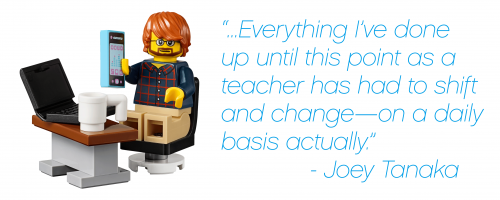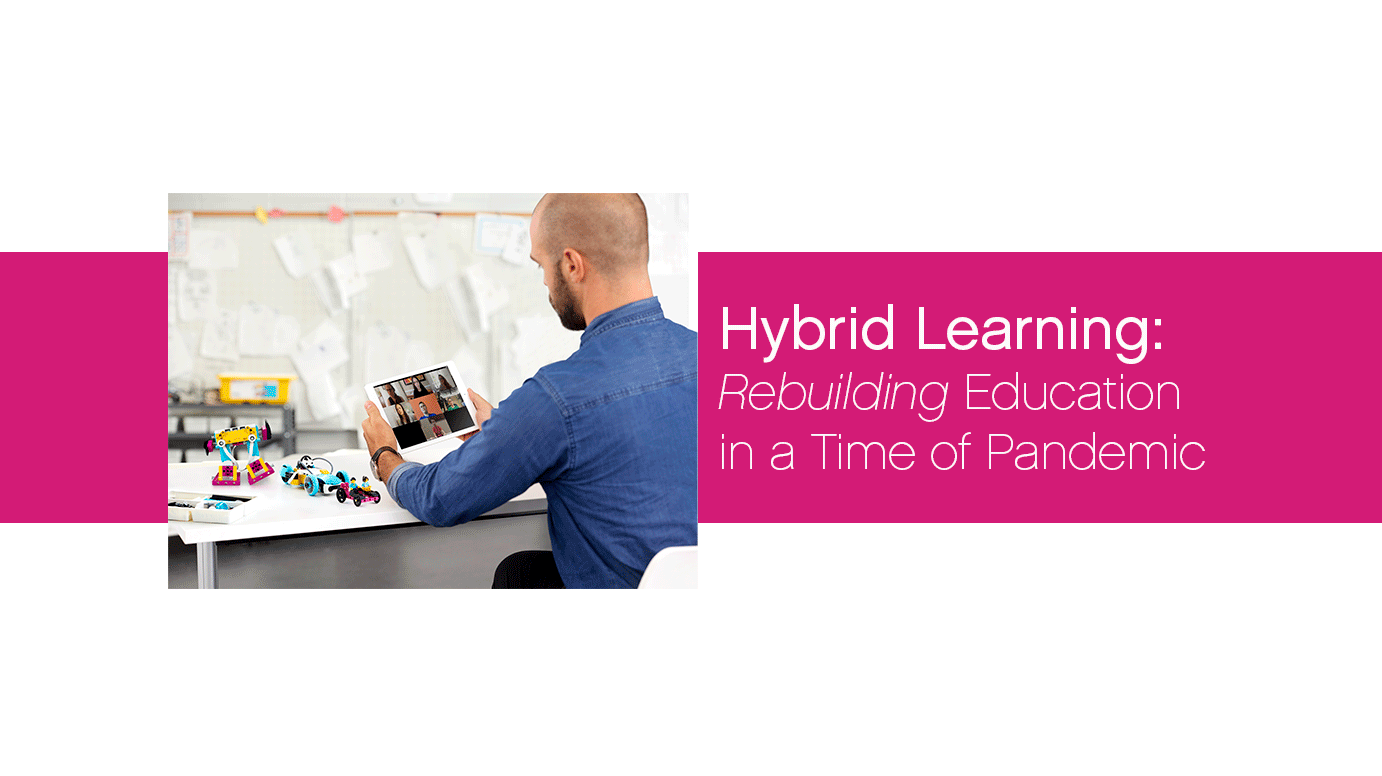Hybrid Learning: Rebuilding Education Together
Published
Hear from LEGO® Education Master Educators on the realities of hybrid learning and how teaching in a time of pandemic calls us to rebuild and reshape education.
As teachers and schools around the world adapt and innovate to meet the challenges of education in a time of pandemic, hybrid learning is the topic of the day. Teachers are trying to answer the questions of how to keep students engaged, and foster things like collaboration as they blend in-person and virtual instruction. The first step is recognizing that the answers aren’t simple and the solutions are as diverse as the student populations they’re addressing. Our Master Educators have offered some great insight into what hybrid learning looks like in practice and the issues they encountered as they implement it. And while their approaches vary with the circumstances and abilities of their students, there are certainly some universal threads.
Joey Tanaka an EdTech and Robotics specialist at the Bertschi School in Seattle articulated it well, “…Everything I’ve done up until this point as a teacher has had to shift and change--on a daily basis actually.” Making that pivot is something most teachers have been dealing with all while trying to keep students excited and focused. “Keeping kids engaged, that’s essentially part of the main role of a teacher and that just looks really different right now…challenging kids at their just-right level has always been really critical, as is connecting with them whether we’re doing it at home or we’re doing it in a classroom setting,” says Tanaka. While it may seem counter-intuitive in a virtual or hybrid environment, the educators we talked to agree that incorporating meaningful play experiences are more important than ever. Dan Thomas, a Tech Ed teacher in Jamestown, New York sees meaningful play as an opportunity for his students to step away from the screen, “They need hands-on activities to get them off the computer, to allow them to be kids and experiment in a playful way.”

Over the summer Thomas was able to send some LEGO® MINDSTORMS® Education EV3 sets home with some of his students. He had a group of about seven or eight kids that he worked with, creating a couple of different projects like a hand slap game using the touch sensor and randomized timing on the motors, and a claw-grabber build that incorporated the medium motor. He used some different tools to allow for sharing and collaboration as well, “I created a Flipgrid so they could record their progress using their phones and got some pretty decent videos that we could do some different stuff with.” By using screen share software, he was also able to create walk-through videos for the programming that the students could use when they ran into trouble. “I’d let them struggle with it a little bit at first and then a couple of days later I’d post my solution and a video of my robot doing whatever the task was and that came in really handy.” It’s a great example of the variety of technologies that teachers have had to master in a short amount of time. Thomas is quick to point out though, that all of the technology in the world is no replacement for the simplicity of one-on-one discussions or an air fist-bump, when it comes to reminding students that you are there for them and they are safe in this learning environment.
Addressing social emotional learning needs adds another layer of complexity to successful hybrid learning, but as we heard recently from Master Educator Naomi Harm it’s more important than ever. Fortunately, the same meaningful play experiences that are so crucial for engaging our students, also naturally promote social emotional skills like empathy, self-regulation, and self-awareness. “We have to think differently about play, and about the opportunity to tinker, because kids need those experiences to connect the learning dots, to feeling safe and build confidence,” says Harm. Design challenges rooted in storytelling are a big part of Harm’s philosophy. She sees them as a real opportunity to empathize with characters as they create scenarios in a way that helps them translate those skills to real life. “I try to make the challenges relevant to them personally, but grounded in the story so they have a compassionate side to relate with the character, then we always try to offer them a design thinking challenge, where they're going to be the creator and put on that scientist, mathematician, or engineer hat and be reminded that they can have an impact on the real world.”
What’s clear no matter how many educators we talk to is that executing successful hybrid and virtual learning strategies isn’t easy. But it’s also clear that learning can continue to be playful, engaging, and effective with a mix of the right resources and planning. We hope this community will serve as one of those resources, and we’re excited to hear how you are keeping learning hands-on, joyful, and holistic in the midst of all the challenges presented by this new educational landscape.
So jump into the comments section and let’s keep the conversation going. The only way we’re going to get through this is together—this is an opportunity to pick each other up, commiserate, and inspire by talking about what you’re doing to continue providing students with the learning experiences they deserve.
Joey Tanaka an EdTech and Robotics specialist at the Bertschi School in Seattle articulated it well, “…Everything I’ve done up until this point as a teacher has had to shift and change--on a daily basis actually.” Making that pivot is something most teachers have been dealing with all while trying to keep students excited and focused. “Keeping kids engaged, that’s essentially part of the main role of a teacher and that just looks really different right now…challenging kids at their just-right level has always been really critical, as is connecting with them whether we’re doing it at home or we’re doing it in a classroom setting,” says Tanaka. While it may seem counter-intuitive in a virtual or hybrid environment, the educators we talked to agree that incorporating meaningful play experiences are more important than ever. Dan Thomas, a Tech Ed teacher in Jamestown, New York sees meaningful play as an opportunity for his students to step away from the screen, “They need hands-on activities to get them off the computer, to allow them to be kids and experiment in a playful way.”

Over the summer Thomas was able to send some LEGO® MINDSTORMS® Education EV3 sets home with some of his students. He had a group of about seven or eight kids that he worked with, creating a couple of different projects like a hand slap game using the touch sensor and randomized timing on the motors, and a claw-grabber build that incorporated the medium motor. He used some different tools to allow for sharing and collaboration as well, “I created a Flipgrid so they could record their progress using their phones and got some pretty decent videos that we could do some different stuff with.” By using screen share software, he was also able to create walk-through videos for the programming that the students could use when they ran into trouble. “I’d let them struggle with it a little bit at first and then a couple of days later I’d post my solution and a video of my robot doing whatever the task was and that came in really handy.” It’s a great example of the variety of technologies that teachers have had to master in a short amount of time. Thomas is quick to point out though, that all of the technology in the world is no replacement for the simplicity of one-on-one discussions or an air fist-bump, when it comes to reminding students that you are there for them and they are safe in this learning environment.
Addressing social emotional learning needs adds another layer of complexity to successful hybrid learning, but as we heard recently from Master Educator Naomi Harm it’s more important than ever. Fortunately, the same meaningful play experiences that are so crucial for engaging our students, also naturally promote social emotional skills like empathy, self-regulation, and self-awareness. “We have to think differently about play, and about the opportunity to tinker, because kids need those experiences to connect the learning dots, to feeling safe and build confidence,” says Harm. Design challenges rooted in storytelling are a big part of Harm’s philosophy. She sees them as a real opportunity to empathize with characters as they create scenarios in a way that helps them translate those skills to real life. “I try to make the challenges relevant to them personally, but grounded in the story so they have a compassionate side to relate with the character, then we always try to offer them a design thinking challenge, where they're going to be the creator and put on that scientist, mathematician, or engineer hat and be reminded that they can have an impact on the real world.”
What’s clear no matter how many educators we talk to is that executing successful hybrid and virtual learning strategies isn’t easy. But it’s also clear that learning can continue to be playful, engaging, and effective with a mix of the right resources and planning. We hope this community will serve as one of those resources, and we’re excited to hear how you are keeping learning hands-on, joyful, and holistic in the midst of all the challenges presented by this new educational landscape.
So jump into the comments section and let’s keep the conversation going. The only way we’re going to get through this is together—this is an opportunity to pick each other up, commiserate, and inspire by talking about what you’re doing to continue providing students with the learning experiences they deserve.
Blog
LEGO® Education Tips and Tricks
10/29/2020 9:48am EDT

Leave a Comment
Students have the option to add more LEGOs to whatever they're building along with a platform. Students check out LEGO people from me to use as part of their build. We were able to get more LEGO people thankfully through a grant on DonorsChoose. When they are finished with the people or build, they put the people in my gray bucket to be cleaned with my ultraviolet light wand, otherwise called "the magic wand."